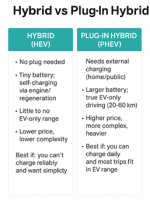Hybrid vs Plug-In Hybrid: Which is Better in 2025?
Choosing between a conventional hybrid (HEV) and a plug-in hybrid (PHEV) can be tricky. Both offer blends of gasoline and electric power, but their real-world performance, costs, and trade-offs diverge significantly. In 2025, with evolving incentives, battery tech, and charging networks, the differences matter more than ever. Let’s explore key factors to help you decide which type suits your driving lifestyle.

What Are They?
- Hybrid (HEV): A hybrid combines a gasoline engine and an electric motor. The battery is charged by regenerative braking and the engine; you don’t plug it in.
- Plug-In Hybrid (PHEV): A PHEV adds a larger battery that can be externally charged. You can drive short distances purely on electric power before the gasoline engine kicks in.
Because of this, a PHEV offers more flexibility, but at a higher cost and complexity.
Key Comparison Factors
Let’s break down the major considerations when comparing HEVs and PHEVs in 2025.
| Factor | Hybrid (HEV) | Plug-In Hybrid (PHEV) |
|---|---|---|
| Upfront Cost / Purchase Premium | Lower premium over non-hybrid models | Higher premium due to larger battery and charger — often thousands more than a hybrid variant (Edmunds) |
| Electric-Only Driving | Generally none (or extremely limited) | Yes — for short-to-medium daily trips (typically 20–60 miles depending on model) |
| Fuel / Energy Savings | Always saves some fuel vs pure gasoline, especially in city driving | Can yield greater savings — if you regularly charge and drive in electric mode |
| Battery Degradation / Replacement Cost | Smaller battery, lower stress | Larger battery; higher cost to replace or maintain |
| Complexity & Maintenance | Simpler drivetrain; fewer parts | More complex (hybrid + battery + charger hardware) (Car and Driver) |
| Incentives & Tax Credits | In some regions, modest or no credits | Often eligible for stronger incentives (depending on jurisdiction) |
| Real-World Efficiency | Good in normal use | Can underperform if battery is rarely charged, or used mostly in gas mode |
| Weight / Efficiency Penalty | Lower weight penalty | Heavier, more components — can offset some gains |
Why PHEVs Can Fall Short of Ideal
Although many PHEVs are marketed as nearly electric cars with gas backup, real-world behaviors often bring developers back toward the drawbacks:
- Many owners do not plug in regularly, relying instead on the gasoline engine, reducing the electric benefit. In the UK, a study found PHEV owners spend £500 more per year on fuel than lab tests predicted.
- Some PHEVs are still less efficient overall when operating beyond their electric range, due to battery weight and drivetrain complexity.
- The premium cost and battery replacement uncertainty can take many years to recover in fuel savings, especially if your driving habits don’t let you exploit the electric range fully.
Thus, a PHEV is only as good as your ability (and discipline) to charge frequently and make many trips within its electric range.
When an HEV Might Make More Sense
- You can’t reliably charge at home or work: If charging is inconvenient, you’ll mostly use gas anyway.
- You drive long distances routinely: Then the electric range of a PHEV may rarely be used fully.
- You prefer lower complexity, lower cost: Fewer parts to maintain or fail.
- You want predictability: HEVs are well understood, with long track records and simpler economies.
When a PHEV Can Shine
- Your daily commuting is within electric range: If your daily drive is under the PHEV’s electric range capacity, you can do a large share of your driving on battery power alone.
- You have reliable charging access: Home charging, workplace charging, or frequent access to chargers.
- Strong incentives apply in your region: Tax credits, rebates, congestion or emissions zone discounts.
- You value flexibility: You don’t want range anxiety on longer trips but want electric driving for most days.
Return on Investment and Payback
A useful metric is “time to breakeven” — how long it takes for fuel savings to offset the higher upfront cost. Many PHEVs require 5–8+ years or very high utilization of electric mode to break even.
For example, Consumer Reports found PHEVs often cost ~15% more than comparable hybrids, and their fuel savings only justify that extra cost under favorable driving patterns.
In another case, Edmunds notes that in models like the Toyota RAV4 or Kia Sportage, the difference between their hybrid and plug-in hybrid versions can exceed $10,000, which demands a lot of “electric miles” to pay back.
Real-World Owner Insights
Reddit threads and owner forums also offer grounded perspectives:
“Plug-In hybrids can drive fully electric for an extended period (often ~30 mi), but cost significantly more … real savings depend on whether you can charge regularly.” Reddit
“I compared PHEV versus hybrid cost — driving within electric range, the PHEV seemed more expensive per mile than the hybrid.”
These anecdotal reports echo published data—behavior and usage patterns make or break the advantage of PHEVs.
Additional Considerations
- Battery warranties and health: PHEVs often come with 8–10 year warranties on battery packs. Check whether these are transferable and how battery degradation is handled.
- Resale value: A PHEV with a strong battery may retain value better; one with a worn battery will hurt resale.
- Regulations and emissions zones: In many cities, PHEVs may still qualify for low-emission perks or exemptions, unlike pure gasoline cars.
- Software & updates: Many modern PHEVs update battery/charging behavior via firmware.
- Insurance & maintenance: More complex systems can mean higher insurance or repair costs over time.
Final Verdict: Which Is “Better”?
- If your driving patterns allow you to leverage electric range daily, and you have reliable charging access, a PHEV can provide more savings and flexibility.
- If you want simplicity, lower cost, and fewer unknowns — or you can’t depend on charging infrastructure — a hybrid (HEV) may be the safer and more predictable choice.
- Neither is perfect — your local incentives, electricity price, gasoline cost, and driving habits are crucial. Always run sample cost models (miles driven, electricity cost, gas cost) before deciding.
